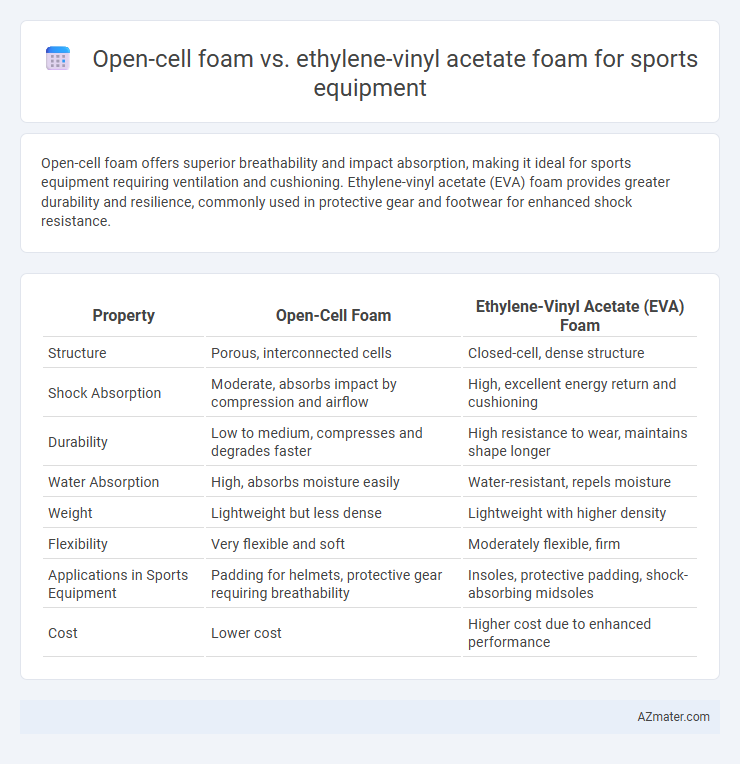Open-cell foam offers superior breathability and impact absorption, making it ideal for sports equipment requiring ventilation and cushioning. Ethylene-vinyl acetate (EVA) foam provides greater durability and resilience, commonly used in protective gear and footwear for enhanced shock resistance.
Table of Comparison
| Property | Open-Cell Foam | Ethylene-Vinyl Acetate (EVA) Foam |
|---|---|---|
| Structure | Porous, interconnected cells | Closed-cell, dense structure |
| Shock Absorption | Moderate, absorbs impact by compression and airflow | High, excellent energy return and cushioning |
| Durability | Low to medium, compresses and degrades faster | High resistance to wear, maintains shape longer |
| Water Absorption | High, absorbs moisture easily | Water-resistant, repels moisture |
| Weight | Lightweight but less dense | Lightweight with higher density |
| Flexibility | Very flexible and soft | Moderately flexible, firm |
| Applications in Sports Equipment | Padding for helmets, protective gear requiring breathability | Insoles, protective padding, shock-absorbing midsoles |
| Cost | Lower cost | Higher cost due to enhanced performance |
Introduction to Sports Equipment Foam Materials
Open-cell foam and ethylene-vinyl acetate (EVA) foam are essential materials in sports equipment due to their distinct properties. Open-cell foam is highly breathable and offers superior cushioning by compressing air within its porous structure, making it ideal for impact absorption in protective gear. EVA foam provides excellent shock absorption, durability, and water resistance, commonly used in shoe soles, padding, and insoles to enhance comfort and performance.
What is Open-Cell Foam?
Open-cell foam is a lightweight, porous material characterized by interconnected air pockets that provide excellent breathability and shock absorption, making it ideal for sports equipment padding. Unlike Ethylene-vinyl acetate (EVA) foam, open-cell foam offers superior cushioning and moisture-wicking properties, enhancing comfort during high-impact activities. Its flexibility and ability to dissipate energy efficiently reduce injury risk, commonly used in protective gear like helmets and knee pads.
Overview of Ethylene-Vinyl Acetate (EVA) Foam
Ethylene-vinyl acetate (EVA) foam, widely used in sports equipment, offers superior shock absorption and flexibility compared to open-cell foam, making it ideal for protective gear and footwear. Its closed-cell structure provides excellent water resistance, durability, and lightweight cushioning, enhancing athlete comfort and performance. EVA foam's ability to maintain shape under stress ensures long-lasting support in high-impact sports applications.
Key Physical and Chemical Properties Comparison
Open-cell foam offers high breathability and excellent shock absorption due to its interconnected pore structure, making it lightweight and highly flexible, whereas ethylene-vinyl acetate (EVA) foam provides superior durability, closed-cell structure, and resistance to water and UV radiation. EVA foam's higher density and resilience deliver enhanced impact cushioning and energy return, ideal for protective gear and insoles, while open-cell foam retains sweat and moisture, leading to faster degradation in sports applications. Chemically, EVA's polymer matrix resists compression set and thermoplastic deformation better than the polyurethane-based open-cell foam, ensuring longer-lasting performance under repeated mechanical stress.
Cushioning and Shock Absorption Performance
Open-cell foam offers superior cushioning and breathability due to its porous structure, making it ideal for comfort in sports equipment padding. Ethylene-vinyl acetate (EVA) foam provides enhanced shock absorption and durability, widely used in midsoles and protective gear for impact resistance. Selecting between these foams depends on the specific requirement for softness versus impact protection in sports applications.
Durability and Longevity for Sports Applications
Open-cell foam offers superior breathability and cushioning but tends to degrade faster under prolonged stress and moisture exposure, making it less durable for intense sports applications. Ethylene-vinyl acetate (EVA) foam exhibits excellent resilience, abrasion resistance, and moisture impermeability, resulting in longer-lasting performance in sports equipment such as shoe midsoles, padding, and protective gear. Choosing EVA foam ensures enhanced durability and longevity, critical for maintaining protective functions and comfort during rigorous athletic activities.
Breathability and Moisture Management
Open-cell foam offers superior breathability due to its porous structure, allowing better air circulation and efficient moisture evaporation, making it ideal for sports equipment requiring high ventilation. Ethylene-vinyl acetate (EVA) foam, while durable and shock-absorbent, has a closed-cell structure that limits airflow and traps moisture, potentially leading to discomfort during intense physical activity. Prioritizing open-cell foam in sports gear enhances moisture management and reduces sweat buildup, promoting better hygiene and athlete comfort.
Weight and Flexibility Considerations
Open-cell foam offers exceptional flexibility due to its porous structure, making it ideal for sports equipment requiring enhanced cushioning and impact absorption with minimal weight. Ethylene-vinyl acetate (EVA) foam provides a denser and more durable material that balances moderate flexibility with lightweight properties, often favored in protective gear and insoles for its shock absorption and resilience. Weight considerations often favor open-cell foam for ultra-light applications, while EVA foam's superior flexibility and compressive strength support equipment designed for repeated high-impact use.
Cost and Sustainability Factors
Open-cell foam typically offers lower manufacturing costs compared to ethylene-vinyl acetate (EVA) foam, making it a budget-friendly option for sports equipment padding and shock absorption. EVA foam exhibits superior durability and resistance to environmental factors, contributing to a longer product lifespan and reducing the frequency of replacements, which enhances sustainability. While open-cell foam is often more biodegradable due to its structure, EVA foam's recyclability programs and energy-efficient production methods increasingly support sustainable practices in the sports equipment industry.
Choosing the Right Foam for Sports Equipment
Open-cell foam offers superior breathability and cushioning, making it ideal for sports equipment requiring moisture control and impact absorption, such as helmets and padding. Ethylene-vinyl acetate (EVA) foam provides excellent shock absorption, durability, and lightweight support, commonly used in shoe midsoles and protective gear. Selecting the right foam depends on balancing factors like density, flexibility, and resistance to wear for optimal performance and athlete comfort.

Infographic: Open-cell foam vs Ethylene-vinyl acetate foam for Sports equipment
 azmater.com
azmater.com